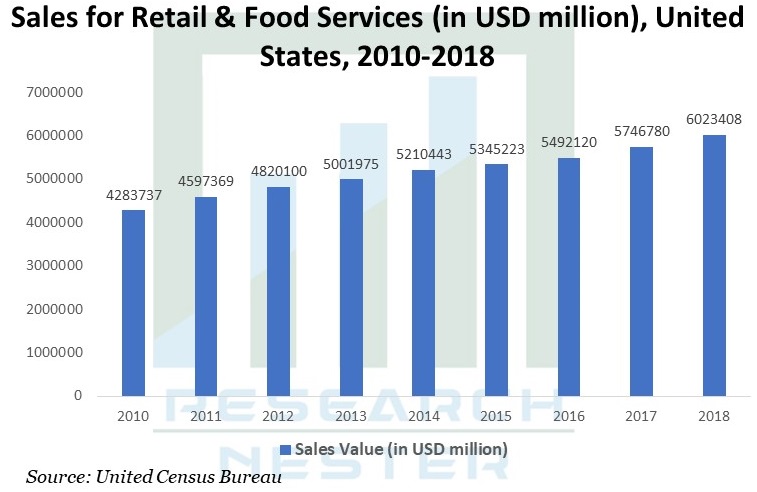Cooking Robot Market Trends
Growth Drivers
Rising Demand for Professional Service Robots Across End User Verticals
According to the statistics by the International Federation of Robotics (IFR), global robot installations increased by 6% to 422,271 units in the year 2018, which was recorded to be worth USD 16.5 billion, is further anticipated to reach around 583,520 units by the end of 2022 by growing at 12% per year on average from 2020 to 2022.
The growing trend of industrial automation across several end user industries, along with the growing trends of Industry 4.0, along with internet of things (IoT) and industrial internet of things (IIoT), backed by the advancements in artificial intelligence (AI) and machine learning (ML), have led to the increasing adoption of robots across the end user industries. Moreover, there is an increasing demand for professional service robots across the foodservice industry, backed by the benefits provided by them, such as sizeable continuous uptime of over 100,000 hours, cloud connectivity, and others. Robots are anticipated to become a crucial part of the cooking process based on their innovative features such as visual recognition, failure prediction, and others. Moreover, technological advancements and developments in the food industry are backing a substantial increase in robot installations throughout the years. Robots' potential to aid the cooking process across kitchens in the food & beverage industry is supplementing the potential of robotics market. Additionally, increasing food safety regulations across the industry is anticipated to drive the global cooking robot market over the coming years. According to the statistics by the World Health Organization (WHO), around 600 million people globally fall ill after eating contaminated food. Further, the statistics also stated that 420,000 people die every year for consuming contaminated food.
Growing Innovations in Food Robotics
There is an increasing need amongst food manufacturers to deliver high quality food by using food robotics owing to the numerous benefits associated with the deployment of robots in the food processing industry. For instance, Moley, a robotics company based in the United Kingdom that creates robots for the use in the kitchen, announced the world's first robotic kitchen that features innovative and advanced, functional robots integrated into a professional kitchen. The robot has the flair & skills comparable to professional chefs. The prototype was showcased at the International Robotics Show, and the consumer version of the innovative solution is set for the launch in late 2020. Similarly, Wilkinson Baking Company offers an automated solution for the production of bread called the Mini Bakery. The computerized solution mixes forms bakes and cools the bread all on its own. Mini Bakery also informs the employees when the bread needs to be sliced. This breadbot is full of innovative features such as automation, consistent ingredient measurement, small footprint, and others. Such factors are anticipated to drive the growth of the global cooking robot market during the forecast period.
Challenges
High Maintenance and Replacement Costs
One of the major restraining factors for the global cooking robotics market is the high cost associated with installation of cooking robots. High capital expenditure associated with the cost of robots along with the maintenance, programming, and integration is amidst the key factors associated with the cost metrics which is inhibiting the adoption of cooking robots across different commercial spaces. Moreover, in certain cases, custom integration of cooking robots is required, which further amplifies the cost of cooking robots. As small & medium-sized enterprises are primarily engaged in low volume utility, ROI is a huge concern. Additionally, fluctuation in economies across the world and the lack of skilled workforce that can understand the output results are some of the additional factors anticipated to hamper the growth of the global cooking robot market.
Cooking Robot Market: Key Insights
The global cooking robot market is thriving on the back of the growing concerns for food safety & hygiene, growing trends for automation across end user industries including the food and beverage industry, increasing demand for robotics-as-a-service, increasing technological innovations for food robotics, rising demand for collaborative robots, followed by the rising use of machine vision and artificial intelligence technologies. The market is also thriving on account of the increasing sales of retail and food services around the world, which is raising the need amongst food chain operators to increase their efficiency speed for faster delivery of food is also anticipated to promote towards the growth of the global cooking robot market. According to the statistics by the United Census Bureau, in the United States, sales for retail and food services increased from USD 4283737 million in the year 2010 to USD 6023408 million in the year 2018.
The global cooking robot market was valued at USD 86170 thousand in the year 2019 and is further projected to reach a value of USD 322568 thousand by the end of 2028 by growing at a CAGR of 16.09% during the forecast period, i.e. 2020-2028.
|
Base Year |
2024 |
|
Forecast Year |
2025-2037 |
|
CAGR |
8.4% |
|
Base Year Market Size (2024) |
USD 3.87 billion |
|
Forecast Year Market Size (2037) |
USD 11.04 billion |
|
Regional Scope |
|

